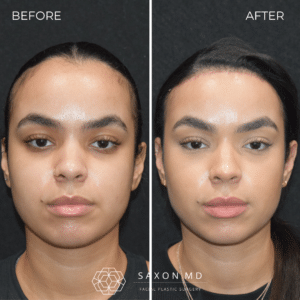Top 5 Things You Wish You Knew Before Hairline Lowering
Hairline lowering surgery, also known as forehead reduction surgery, is a popular procedure for those looking to decrease the height of their forehead or lower their hairline. While the procedure can be transformative, there are crucial considerations to keep in mind before deciding to undergo this surgery. Here are the top five things you wish you knew before hairline lowering surgery.

1. There Will Always Be a Scar
One of the most important things to be aware of is that hairline lowering surgery will inevitably leave a scar. The incision is typically made along the hairline, and while any surgeon aims to make it as inconspicuous as possible, some scarring is unavoidable. The visibility of the scar can vary based on your skin type, healing process, and how well you follow post-operative care instructions. Dr. Saxon uses several techniques to minimize scarring including use of platelet rich fibrin and minimizing tension with deep sutures.
The incision is also made so that hair can grow through the incision over time. This is called a trichophytic incision. Even if the scar heals ideally, it can be hypopigmented or hyperpigmented. Silicone-based gels with SPF, like Silagen, is recommended after hairline lowering surgery to minimize this. Despite all best efforts, sometimes a visible scar is still present, which may require skin treatments like microneedling or lasers. Medical tattooing can also be used to match the pigment of the scar to the surrounding skin.
2. It Is Not a Good Procedure for Men
Hairline lowering surgery is generally not recommended for men, particularly those who are experiencing or are likely to experience male pattern baldness. Men with receding hairlines might find that the surgery doesn’t provide a long-term solution, as ongoing hair loss could counteract the benefits of the procedure. For men, other options such as hair transplants might be more suitable.
3. Shock Hair Loss Can Happen
Shock hair loss, also known as telogen effluvium, is a temporary hair loss that can occur after surgical trauma. This means that the hair surrounding the incision site may fall out as a reaction to the surgery. While this hair loss is typically temporary and the hair usually grows back, it can be distressing to experience. Understanding this possibility can help you prepare mentally for the initial post-surgery period. Read more about shock hair loss here.
 .
. 
4. It Can Take Time to Regain Sensation in the Scalp
Another aspect to consider is that it can take a considerable amount of time to regain full sensation in your scalp after hairline lowering surgery. The nerves in the scalp can be affected during the procedure, leading to numbness or tingling sensations. While most people gradually regain normal sensation, it can take several months or even up to a year for the nerves to fully recover. In some rare cases, some areas might remain permanently numb.
5. You May Not Be Able to Lower Your Hairline Enough
While hairline lowering surgery can significantly reduce the height of your forehead, there are limitations to how much the hairline can be lowered. Factors such as the elasticity of your skin and the amount of scalp mobility can affect the extent of the lowering. Typically, the scalp can be advanced about 2-3 centimeters during hairline lowering surgery but this can vary.
If you have significant hair thinning or loss in the temples, additional hair grafts may be needed in select locations. During your consultation, Dr. Saxon will assess these factors and provide you with a realistic expectation of the results. It’s crucial to have an open discussion about your desired outcome and understand the potential limitations.
Is Hairline Lowering Surgery Right for You?
Hairline lowering surgery can offer dramatic improvements for those seeking a lower hairline, but it is not without its challenges and limitations. By being well-informed, you can make a more educated decision and have realistic expectations for the results of your surgery.